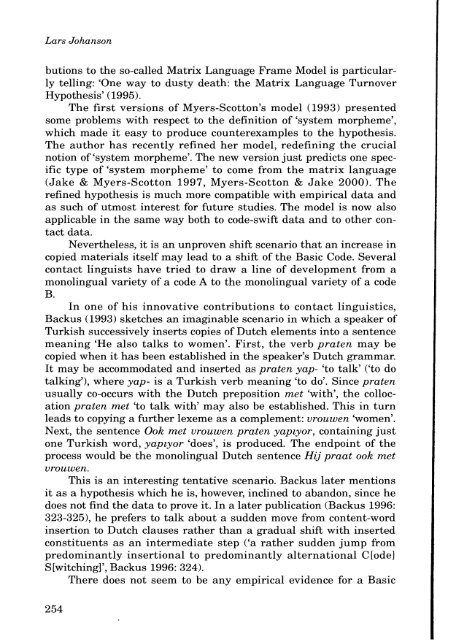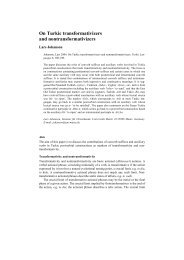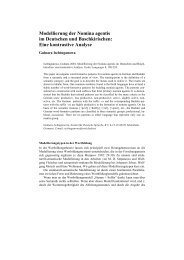Code-Copying - Turkic Languages
Code-Copying - Turkic Languages
Code-Copying - Turkic Languages
- No tags were found...
You also want an ePaper? Increase the reach of your titles
YUMPU automatically turns print PDFs into web optimized ePapers that Google loves.
utions to the so-called Matrix Language Frame Model is particularly<br />
telling: 'One way to dusty death: the Matrix Language Turnover<br />
Hypothesis' (1995).<br />
The first versions of Myers-Scotton's model (1993) presented<br />
some problems with respect to the definition of 'system morpheme',<br />
which made it easy to produce counterexamples to the hypothesis.<br />
The author has recently refined her model, redefining the crucial<br />
notion of 'system morpheme'. The new version just predicts one specific<br />
type of 'system morpheme' to come from the matrix language<br />
(Jake & Myers-Scotton 1997, Myers-Scotton & Jake 2000). The<br />
refined hypothesis is much more compatible with empirical data and<br />
as such of utmost interest for future studies. The model is now also<br />
applicable in the Same way both to code-swift data and to other contact<br />
data.<br />
Nevertheless, it is an unproven shift scenario that an increase in<br />
copied materials itself may lead to a shift of the Basic <strong>Code</strong>. Several<br />
contact linguists have tried to draw a line of development from a<br />
monolingual variety of a code A to the monolingual variety of a code<br />
B.<br />
In one of his innovative contributions to contact linguistics,<br />
Backus (1993) sketches an imaginable scenario in which a speaker of<br />
Turkish successively inserts copies of Dutch elements into a sentence<br />
meaning 'He also talks to women'. First, the verb praten may be<br />
copied when it has been established in the speaker's Dutch grammar.<br />
It may be accommodated and inserted as praten yap- 'to talk' ('to do<br />
talking'), where yap- is a Turkish verb meaning 'to do'. Since pratm<br />
usually CO-occurs with the Dutch preposition met 'with', the collocation<br />
praten met 'to talk with' may also be established. This in turn<br />
leads to copying a further lexeme as a complement: vrouwen 'women'.<br />
Next, the sentence Ook met urouwen praten yapyor, containing just<br />
one Turkish word, yapzyor 'does', is produced. The endpoint of the<br />
process would be the monolingual Dutch sentence Hij praat ook met<br />
urouwen.<br />
This is an interesting tentative scenario. Backus later mentions<br />
it as a hypothesis which he is, however, inclined to abandon, since he<br />
does not find the data to prove it. In a later publication (Backus 1996:<br />
323-3251, he prefers to talk about a sudden move from content-word<br />
insertion to Dutch clauses rather than a gradual shift with inserted<br />
constituents as an intermediate step ('a rather sudden jump from<br />
predominantly insertional to predominantly alternational C[ode]<br />
S[witchingI7, Backus 1996: 324).<br />
There does not seem to be any empirical evidence for a Basic




